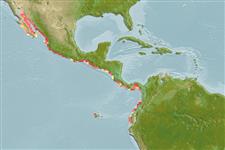Actinopterygii (ray-finned fishes) >
Siluriformes (Catfish) >
Ariidae (Sea catfishes) > Bagreinae
Etymology: Bagre: Mozarabic, bagre, taken from Greek, pagros = a fish (Dentex sp.) (Ref. 45335).
Environment / Climate / Range
Ecology
Marine; freshwater; brackish; demersal. Tropical, preferred ?; 32°N - 3°S, 114°W - 77°W
North, Central and South America: Pacific draining rivers from the Gulf of California to Ecuador.
Size / Weight / Age
Maturity: Lm ? range ? - ? cm
Max length : 95.0 cm TL male/unsexed; (Ref. 55763); common length : 30.0 cm TL male/unsexed; (Ref. 55763)
Body robust, rounded anteriorly and compressed posteriorly; mouth sub-terminal and wide; teeth villiform, arranged in a narrow band followed by four narrow continuous bands across the palate; two pairs of barbels, the maxillary barbels long and ribbon-like; dorsal and pectoral fin spines long. Body brown; back metallic blue or bright violet; belly silvery gray; fins yellowish green; a black spot present anterior to the anal fin (Ref. 55763).
Adults are found in coastal waters (Ref. 9271). Marketed fresh, salted, dried and smoked (Ref. 9271).
Life cycle and mating behavior
Maturity | Reproduction | Spawning | Eggs | Fecundity | Larvae
Kailola, P.J. and W.A. Bussing, 1995. Ariidae. Bagres marinos. p. 860-886. In W. Fischer, F. Krupp, W. Schneider, C. Sommer, K.E. Carpenter and V. Niem (eds.) Guia FAO para Identification de Especies para lo Fines de la Pesca. Pacifico Centro-Oriental. 3 Vols. FAO, Rome. (Ref. 9271)
IUCN Red List Status (Ref. 115185)
CITES (Ref. 94142)
Not Evaluated
Threat to humans
Traumatogenic (Ref. 58010)
Human uses
Fisheries: commercial
More information
Common namesSynonymsMetabolismPredatorsEcotoxicologyReproductionMaturitySpawningFecundityEggsEgg development
ReferencesAquacultureAquaculture profileStrainsGeneticsAllele frequenciesHeritabilityDiseasesProcessingMass conversion
Tools
Special reports
Download XML
Internet sources
